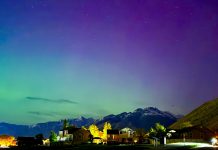
Sept. 23 (UPI) — Monday officially marks the first day of the fall, with the autumn equinox — an event for which much of the world experiences the same amount of light and darkness because the sun shines at the equator.
The equinox, meaning “equal night” began at 3:50 a.m. EDT Monday, and both the Northern and Southern Hemispheres experience 12 hours of day and 12 hours of night.
Not all of the world will see the same amount, however. Fairbanks, Alaska, will experience 12 hours and 11 minutes of daylight while Key West, Fla., will see 12 hours and six minutes, according to Time&Date.com.
The phenomenon occurs twice a year when the tilt of the Earth’s axis positions its center in line with the sun, placing the line that separates day and night — known as the terminator line, the “grey line” or the “twilight zone” — concurrent with the equator.
“At the equator, the sun is directly overhead at noon on these two equinoxes,” the National Weather Service says. “The ‘nearly’ equal hours of day and night is due to refraction of sunlight and or a bending of the light’s rays that causes the sun to appear above the horizon when the actual position of the sun is below the horizon.”
The autumnal equinox is also considered the beginning of astronomical fall.
“The natural rotation of earth around the sun forms the basis for the astronomical calendar, in which we define seasons with two solstices and two equinoxes,” according to the NOAA.
The fall equinox also results in increased visibility for the Northern Lights. They are typically only visible above the Arctic Circle between 64 degrees and 70 degrees North latitudes in Alaska, northern Canada, southern Greenland, Iceland, the Faroe Islands, northwest Russia and the northern regions of Norway, Sweden and Finland.
During the autumnal equinox, the so-called “aurora zone,” where the Northern Lights are visible, expands and creates a chance that the phenomenon can be viewed further south.
The vernal, or spring, equinox occurred March 20, and the summer solstice — in which the Earth is closest to the sun in the northern hemisphere, resulting in the longest day of the year — on June 20. The winter solstice, of the first official day of winter, will occur Dec. 21 and will be the year’s shortest day.





